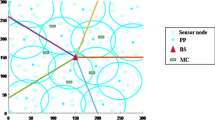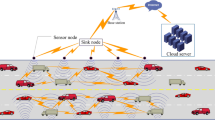Abstract
In this paper, a distributed method for coverage optimization of random deployed WMSNs utilizing motility and mobility capabilities of nodes, is proposed. The aims followed by the method are first, maximizing the coverage ratio by minimizing both the covered overlapping areas, and the coverage holes after random deployment, and second, enhancing energy efficiency of the coverage optimization procedure, by minimizing the needed rotations and specially movements, comparing with the previous schemes. To these aims, the most appropriate location and orientation of the nodes are calculated round by round considering all the possible nested compositions of rotation and movement. But, rotating and moving the nodes are performed after terminating the algorithm rounds and achieving the decisive results. So, the proposed method does not impose the overhead of trial and error of rotation or relocation on the network nodes. The performance of the proposed approach has been compared with the previous works for different network configurations; simulation results show that the proposed approach outperforms the previous schemes in terms of both coverage ratio and energy efficiency.















Similar content being viewed by others
References
Ajith Kumar, A. S., Øvsthus, K., & Kristensen, L. M. (2014). An industrial perspective on wireless sensor networks: A survey of requirements, protocols, and challenges. IEEE Communications Surveys and Tutorials, 16(3), 1391–1412.
Seema, A., & Reisslein, M. (2011). Towards efficient wireless video sensor networks: A survey of existing node architectures and proposal for a flexi-WVSNP design. IEEE Communications Surveys and Tutorials, 13(3), 462–486.
Fei, Z., Li, B., Yang, S., Xing, C., Chen, H., & Hanzo, L. (2017). A survey of multi-objective optimization in wireless sensor networks: Metrics, algorithms, and open problems. IEEE Communications Surveys and Tutorials, 19(1), 550–586.
Wang, B., Lim, H. B., & Ma, D. (2009). A survey of movement strategies for improving network coverage in wireless sensor networks. Computer Communications, 32(13), 1427–1436.
Abo-Zahhad, M., Sabor, N., Sasaki, S., & Ahmed, S. M. (2016). A centralized immune-Voronoi deployment algorithm for coverage maximization and energy conservation in mobile wireless sensor networks. Information Fusion, 30, 36–51.
Ma, C. Y., Yau, D. K., Yip, N. K., Rao, N. S., & Chen, J. (2012). Stochastic steepest descent optimization of multiple-objective mobile sensor coverage. IEEE Transactions on Vehicular Technology, 61(4), 1810–1822.
Kim, D., Wang, W., Son, J., Wu, W., Lee, W., & Tokuta, A. O. (2017). Maximum lifetime combined barrier-coverage of weak static sensors and strong mobile sensors. IEEE Transactions on Mobile Computing, 16(7), 1956–1966.
Rout, M., & Roy, R. (2016). Self-deployment of randomly scattered mobile sensors to achieve barrier coverage. IEEE Sensors Journal, 16(18), 6819–6820.
Habibi, J., Mahboubi, H., & Aghdam, A. (2016). A gradient-based coverage optimization strategy for mobile sensor networks. IEEE Transactions on Control of Network Systems. https://doi.org/10.1109/TCNS.2016.2515370.
Bai, X., Yun, Z., Xuan, D., Chen, B., & Zhao, W. (2011). Optimal multiple coverage of sensor networks. In Proceedings of the 30th IEEE international conference on computer communications (INFOCOM), Shanghai, China (pp. 2498–2506).
Sangwan, A., & Singh, R. P. (2015). Survey on coverage problems in wireless sensor networks. Wireless Personal Communications, 80(4), 1475–1500.
Aghdasi, H. S., & Abbaspour, M. (2016). Energy efficient area coverage by evolutionary camera node scheduling algorithms in visual sensor networks. Soft Computing, 20(3), 1191–1202.
Guvensan, M. A., & Yavuz, A. G. (2011). On coverage issues in directional sensor networks: A survey. Ad Hoc Networks, 9(7), 1238–1255.
Costa, D. G., & Guedes, L. A. (2010). The coverage problem in video-based wireless sensor networks: A survey. Sensors, 10(9), 8215–8247.
Charfi, Y., Wakamiya, N., & Murata, M. (2009). Challenging issues in visual sensor networks. IEEE Wireless Communications Magazine, 16(2), 44–49.
Alaei, M., & Barcelo-Ordinas, J. M. (2013). A collaborative node management scheme for energy-efficient monitoring in wireless multimedia sensor networks. Wireless Networks, 19(5), 639–659.
Jing, Z., & Jian-Chao, Z. (2010). A virtual centripetal force-based coverage-enhancing algorithm for wireless multimedia sensor networks. IEEE Sensors Journal, 10(8), 1328–1334.
Yang, C., Zhu, W., Liu, J., Chen, L., Chen, D., & Cao, J. (2015). Self-orienting the cameras for maximizing the view-coverage ratio in camera sensor networks. Journal of Pervasive and Mobile Computing, 17(1), 102–121.
Tezcan, N., & Wang, W. (2008). Self-orienting wireless multimedia sensor networks for occlusion-free viewpoints. Computer Networks, 52(13), 2558–2567.
Hsu, Y. C., Chen, Y. T., & Liang, C. K. (2012). Distributed coverage-enhancing algorithms in directional sensor networks with rotatable sensors. Lecture notes in computer science (Vol. 7129, pp. 201–213). New York: Springer.
Sung, T.-W., & Yang, C.-S. (2014). Voronoi-based coverage improvement approach for wireless directional sensor networks. Journal of Network and Computer Applications, 39(1), 202–213.
Li, J., Wangr, R., Huang, H., & Sun, L. (2009). Voronoi-based coverage optimization for directional sensor networks. Wireless Sensor Network, 1, 417–424.
Yildiz, E., et al. (2014). Optimal camera placement for providing angular coverage in wireless video sensor networks. IEEE Transactions on Computers, 63(7), 1812–1825.
Liu, X., Yang, B., Zhao, S., & Fan, Y. (2016). Achieving full-view barrier coverage with mobile camera sensors. In International conference on networking and network applications (NaNA), Hakodate, Japan (pp. 73–76).
Liang, C. K., He, M. C., & Tsai, C. H. (2010). Movement assisted sensor deployment in directional sensor networks. In 2010 Sixth international conference on mobile ad hoc and sensor networks (MSN), Hangzhou, China, 2010.
Xu, Y.-C., Lei, B., & Hendriks, E. A. (2013). Constrained particle swarm algorithms for optimizing coverage of large-scale camera networks with mobile nodes. Soft Computing, 17(6), 1047–1057.
Nam, Y., & Hong, S. (2014). Optimal placement of multiple visual sensors considering space coverage and cost constraints. Multimedia Tools and Applications, 73(1), 129–150.
Guvensan, M. A., & Yavuz, A. G. (2013). Hybrid movement strategy in self-orienting directional sensor networks. Ad Hoc Networks, 11(3), 1075–1090.
Nene, M. J., Deodhar, R. S., & Patnaik, L. M. (2015). Algorithm for autonomous reorganization of mobile wireless camera sensor networks to improve coverage. IEEE Sensors Journal, 15(8), 4428–4441.
Yetgin, H., Cheung, K. T., El-Hajjar, M., & Hanzo, L. (2017). A survey of network lifetime maximization techniques in wireless sensor networks. IEEE Communications Surveys and Tutorials, 19(2), 828–854.
Chen, H., Wu, H., & Tzeng, N.-F. (2004). Grid-based approach for working node selection in wireless sensor networks. In IEEE international conference on communications (ICC) (pp. 3673–3678).
Author information
Authors and Affiliations
Corresponding author
Rights and permissions
About this article
Cite this article
Pournazari, J., Alaei, M. & Yazdanpanah, F. An Energy Efficient Autonomous Method for Coverage Optimization in Wireless Multimedia Sensor Networks. Wireless Pers Commun 99, 717–736 (2018). https://doi.org/10.1007/s11277-017-5142-y
Published:
Issue Date:
DOI: https://doi.org/10.1007/s11277-017-5142-y




